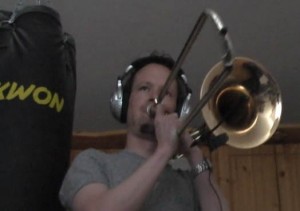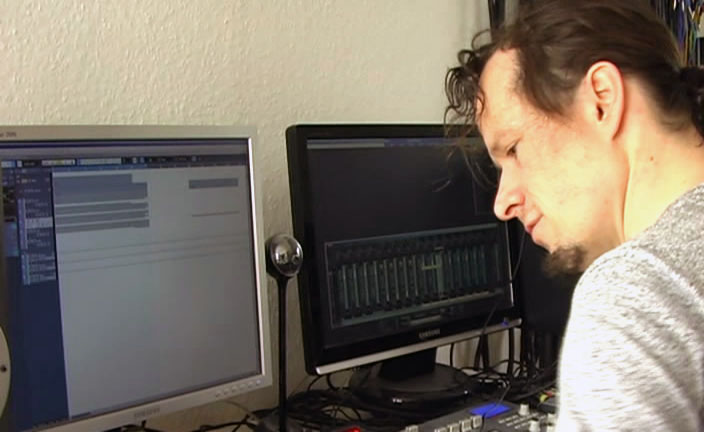There’s another track – written just the evening before.
The idea was to combine something fast, arhythmical with a four-voice trombone aequal (something I haven’t done since Summer Evenings in Niederbayern off JANUS). So I sat down and started a simple sketch in Cubase – again, only something like twenty seconds.
The first plan included to combine the trombones with a soprano sax, but later on, I came to the conclusion that this was much too hard to master for me.
 Recording the trombone was a straightforward (and compared with other acoustic instrument recordings in this project) simple affair: trombone into AT4050 into QuadMic. Incidentially, the four parts were recorded rather quickly – luckily, before someone in the same house started to bring out his percussion drill.
Recording the trombone was a straightforward (and compared with other acoustic instrument recordings in this project) simple affair: trombone into AT4050 into QuadMic. Incidentially, the four parts were recorded rather quickly – luckily, before someone in the same house started to bring out his percussion drill.
While there’s still some issues with my cabling (for some reason, I can’t seem to get both channels on my headphone feed via the multicore working – need to check into the rack sometime soon), simply setting a fixed standing position (putting the trombone about 60cm from the microphone) and playing away worked well – albeit with a very punchy, straightforward sound which called for some slight treatment.
However, this wasn’t what I had in mind as a main goal with regard to mixing.
Back during the mixing sessions for A Tätowierte Katz’, I had for the first time used what I’d like to call “proper panning”. Usually, turning the pan pot on a mixing console between half-left and half-right gives you what roughly corresponds to an X/Y coincidental microphone setup. Anything outside of this range is rather surreal, and leads to a very pronounced in-head-localization (which you can find in a lot of pop productions, most prominently the hard-panned early Beatles albums).
what I’d like to call “proper panning”. Usually, turning the pan pot on a mixing console between half-left and half-right gives you what roughly corresponds to an X/Y coincidental microphone setup. Anything outside of this range is rather surreal, and leads to a very pronounced in-head-localization (which you can find in a lot of pop productions, most prominently the hard-panned early Beatles albums).
For A Tätowierte Katz’, I had used omnis both for the drum overheads and for the wide-spaced room microphones, to give an A/B combined transit-time/level stereophony. Yet there were also close mics, so how to mix them?
The simple process: measure the distance of the close mics to the omnis, then use a fancy spreadsheet to calculate pan settings AND stereo delay settings for each of those channels. The result is a very convincing stereo image which not only allows you to discern left and right, but also back and front.
This process was also used for this track. Yes, there were no room omnis for this recording, but this didn’t keep me from proceeding in exactly the same way: I simply assumed there was a wide-spaced pair of omnis in front of the (virtual) four-piece trombone section, then calculated the distances to each omni from those virtual standing positions, and using those distances could calculate delay and pan values. Voila!
I did however decide against doing this with the soprano sax, simply because I didn’t record one. The simple reason: as I already had some difficulity getting the rather simple sax part on one of the previous tunes done, I figured this a little challenging one would really be too much for me. So I decided on a synthesizer – the first patch I chose will by all propability not be my final choice, though.

